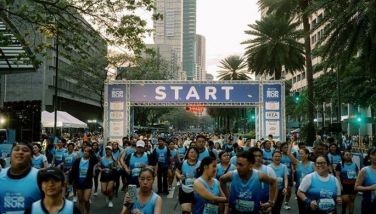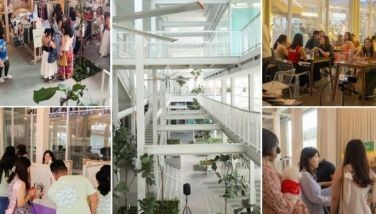Japan's Koominkan
April 27, 2006 | 12:00am
All throughout Japan, there are public ward halls or Koominkan. We are all familiar with our barangay halls all throughout Philippine cities and municipalities. Japan's Koominkan, in one sense, may be likened to our barangay/municipal halls but only in terms of their presence in an administrative area. Unlike our barangay/municipal halls that house elected officials and that center on political and administrative matters, Japan's Koominkan, intended for public service and use, is managed by civilian staff members and volunteers, not politicians.
The Koominkan renders various public service functions. One, it serves as a communication network, where publications and announcements about major welfare and cultural events are made available to the area's constituents. These publications and announcements are produced by various groups, not necessarily just by the Kouminkan staff. NGO newsletters as well as health and cultural groups are left here for public consumption. Calendars regarding waste collection per area are also made available.
The Koominkan also serves as training area for various skills and hobbies. Interested individuals can sign for scheduled classes for ikebana (Japanese flower arrangement), ballroom dancing for the elderly, ballet class for the very young, yoga, English classes, Japanese calligraphy, musical choirs. For a very minimal monthly charge, the Kouminkan links professionals who have skills to offer with residents who want to spend their time more productively, within a social circle.
The Koominkan also provides rooms and spaces not only for hobby and skills training mentioned earlier. The rooms and spaces can be used for meetings and small gatherings and are made available for free, advanced registration being the only requirement to ensure the availability of the space.
The Koominkan also serves as a public learning center, as there is a small library with books, magazines, newspapers and other reading materials available to interested readers.
A computer with Internet service is also made available for those who want to use this service, and this is available for free.
Koominkan also serve as information centers where one can ask about the transport schedule, directions to certain addresses and other concerns.
Scattered all throughout Japan, free, friendly public service is assured to all residents through the Koominkan on a daily basis, from Mondays to Saturdays.
Important health and welfare information are also made available to all. For example, there are regular schedules for vaccination of children and dogs, breast examination, and other health and welfare activities. Often, these health and welfare services are offered for free once or twice a year by the local and/or national government.
Residents of an area are assured of public service from the staff of Koominkan who are so open, friendly and generous
with their time and attention.
The presence of the Koominkan assures continuing non-formal education as well as for the area's residents of all age groups. More importantly, the Koominkan assure the residents of continuing service and care from their governments, whether local or national, and from civil society groups and organizations.
The simple, inexpensive, effective, people-friendly Koominkan system of Japan may be worth considering for every barangay in our country. Rather than house politicians like our present barangay/municipal/city halls and Congress, our people deserve public service halls/centers where their cultural, educational, health and welfare needs are attended to daily by enthusiastic, energetic public servants.
The Koominkan renders various public service functions. One, it serves as a communication network, where publications and announcements about major welfare and cultural events are made available to the area's constituents. These publications and announcements are produced by various groups, not necessarily just by the Kouminkan staff. NGO newsletters as well as health and cultural groups are left here for public consumption. Calendars regarding waste collection per area are also made available.
The Koominkan also serves as training area for various skills and hobbies. Interested individuals can sign for scheduled classes for ikebana (Japanese flower arrangement), ballroom dancing for the elderly, ballet class for the very young, yoga, English classes, Japanese calligraphy, musical choirs. For a very minimal monthly charge, the Kouminkan links professionals who have skills to offer with residents who want to spend their time more productively, within a social circle.
The Koominkan also provides rooms and spaces not only for hobby and skills training mentioned earlier. The rooms and spaces can be used for meetings and small gatherings and are made available for free, advanced registration being the only requirement to ensure the availability of the space.
The Koominkan also serves as a public learning center, as there is a small library with books, magazines, newspapers and other reading materials available to interested readers.
A computer with Internet service is also made available for those who want to use this service, and this is available for free.
Koominkan also serve as information centers where one can ask about the transport schedule, directions to certain addresses and other concerns.
Scattered all throughout Japan, free, friendly public service is assured to all residents through the Koominkan on a daily basis, from Mondays to Saturdays.
Important health and welfare information are also made available to all. For example, there are regular schedules for vaccination of children and dogs, breast examination, and other health and welfare activities. Often, these health and welfare services are offered for free once or twice a year by the local and/or national government.
Residents of an area are assured of public service from the staff of Koominkan who are so open, friendly and generous
with their time and attention.
The presence of the Koominkan assures continuing non-formal education as well as for the area's residents of all age groups. More importantly, the Koominkan assure the residents of continuing service and care from their governments, whether local or national, and from civil society groups and organizations.
The simple, inexpensive, effective, people-friendly Koominkan system of Japan may be worth considering for every barangay in our country. Rather than house politicians like our present barangay/municipal/city halls and Congress, our people deserve public service halls/centers where their cultural, educational, health and welfare needs are attended to daily by enthusiastic, energetic public servants.
BrandSpace Articles
<
>
- Latest
- Trending
Trending
Latest



























